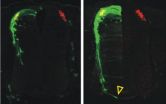(Press-News.org) In the future, tiny air vehicles may be able to fly through cracks in concrete to search for earthquake victims, explore a contaminated building or conduct surveillance missions for the military. But today, designing the best flying mechanism for these miniature aerial machines is still a challenging task.
Creating micro-scale air vehicles that mimic the flapping of winged insects or birds has become popular, but they typically require a complex combination of pitching and plunging motions to oscillate the flapping wings. To avoid some of the design challenges involved in mimicking insect wing strokes, researchers at the Georgia Institute of Technology propose using flexible wings that are driven by a simple sinusoidal flapping motion.
"We found that the simple up and down wavelike stroke of wings at the resonance frequency is easier to implement and generates lift comparable to winged insects that employ a significantly more complex stroke," said Alexander Alexeev, an assistant professor in Georgia Tech's School of Mechanical Engineering.
Details of the flapping motion proposed by Alexeev and mechanical engineering graduate student Hassan Masoud were presented on Nov. 22 at the 63rd Annual Meeting of the American Physical Society Division of Fluid Dynamics. A paper published in the May issue of the journal Physical Review E also reported on this work, which is supported in part by the National Science Foundation through TeraGrid computational resources.
In nature, flapping-wing flight has unparalleled maneuverability, agility and hovering capability. Unlike fixed-wing and rotary-wing air vehicles, micro air vehicles integrate lifting, thrusting and hanging into a flapping wing system, and have the ability to cruise a long distance with a small energy supply. However, significant technical challenges exist in designing flapping wings, many motivated by an incomplete understanding of the physics associated with aerodynamics of flapping flight at small size scales.
"When you want to create smaller and smaller vehicles, the aerodynamics change a lot and modeling becomes important," said Alexeev. "We tried to gain insight into the flapping aerodynamics by using computational models and identifying the aerodynamic forces necessary to drive these very small flying machines."
Alexeev and Masoud used three-dimensional computer simulations to examine for the first time the lift and hovering aerodynamics of flexible wings driven at resonance by sinusoidal oscillations. The wings were tilted from the horizontal and oscillated vertically by a force applied at the wing root. To capture the dynamic interactions between the wings and their environment, the researchers used a hybrid computational approach that integrated the lattice Boltzmann model for fluid dynamics and the lattice spring model for the mechanics of elastic wings.
The simulations revealed that at resonance -- the frequencies when a system oscillates at larger amplitudes -- tilted elastic wings driven by a simple harmonic stroke generated lift comparable to that of small insects that employ a significantly more complex stroke. In addition, the simulations identified one flapping regime that enabled maximum lift and another that revealed maximum efficiency. The efficiency was maximized at a flapping frequency 30 percent higher than the frequency for maximized lift.
"This information could be useful for regulating the flight of flapping-wing micro air vehicles since high lift is typically needed only during takeoff, while the enhanced aerodynamic efficiency is essential for a long-distance cruise flight," noted Masoud.
To facilitate the design of practical micro-scale air vehicles that employ resonance flapping, the researchers plan to examine how flapping wings can be effectively controlled in different flow conditions including unsteady gusty environments. They are also investigating whether wings with non-uniform structural and mechanical properties and wings driven by an asymmetric stroke may further improve the resonance performance of flapping wings.
INFORMATION:
Flexible wings driven by simple oscillation may be viable for efficient micro air vehicles
2010-11-23
ELSE PRESS RELEASES FROM THIS DATE:
Putting the squeeze on fat cells
2010-11-23
From fad diets to exercise programs, Americans continue to fight the battle of the bulge. Now they'll have help from recent Tel Aviv University research that has developed a new method to look at how fat cells -- which produce the fat in our bodies -- respond to mechanical loads.
This might be the key to understanding how to control the amount of fat produced by fat cells, the holy grail of weight loss researchers, says Prof. Amit Gefen of Tel Aviv University's Department of Biomedical Engineering. His research is driven by the theory that fat cells, like bone or muscle ...
Scientists clock on to how sunlight shapes daily rhythms
2010-11-23
Fresh insight into how biological clocks adjust to having less sunlight in the winter could help us better understand the impact of jet lag and shift work.
Scientists studying the daily activity cycle in plants – known as circadian rhythms – have discovered a finely tuned process that enables the plant's genes to respond to the times of dawn and dusk each day, as well as the length of daylight in between.
This system helps the plant to reset its internal clock every day in response to seasonal changes in daylight, which helps the plant control the timing of key activities ...
Bacteria help infants digest milk more effectively than adults
2010-11-23
Infants are more efficient at digesting and utilizing nutritional components of milk than adults due to a difference in the strains of bacteria that dominate their digestive tracts. Researchers from the University of California, Davis, and Utah State University report on genomic analysis of these strains in the November 2010 issue of the journal Applied and Environmental Microbiology identifying the genes that are most likely responsible for this difference.
"Human milk oligosaccharides (HMOs) are the third-largest solid component of milk. Their structural complexity ...
Hong Kong hospital reports possible airborne influenza transmission
2010-11-23
Direct contact and droplets are the primary ways influenza spreads. Under certain conditions, however, aerosol transmission is possible. In a study published in the current issue of Clinical Infectious Diseases, available online (http://www.journals.uchicago.edu/doi/abs/10.1086/656743), the authors examined such an outbreak in their own hospital in Hong Kong.
On April 4, 2008, seven inpatients in the hospital's general medical ward developed fever and respiratory symptoms. Ultimately, nine inpatients exhibited influenza-like symptoms and tested positive for influenza ...
Researchers kick-start ancient DNA
2010-11-23
BINGHAMTON, NY – Binghamton University researchers recently revived ancient bacteria trapped for thousands of years in water droplets embedded in salt crystals.
For decades, geologists have looked at these water droplets — called fluid inclusions — and wondered whether microbes could be extracted from them. Fluid inclusions have been found inside salt crystals ranging in age from thousands to hundreds of millions years old.
But there has always been a question about whether the organisms cultured from salt crystals are genuinely ancient material or whether they are ...
MU scientist develops salmonella test that makes food safer, reduce recalls
2010-11-23
VIDEO:
University of Missouri researchers have created a new test for salmonella in poultry and eggs that will produce faster and more accurate results than most currently available tests.
Click here for more information.
COLUMBIA, Mo. –Earlier this year, an outbreak of salmonella caused by infected eggs resulted in thousands of illnesses before a costly recall could be implemented. Now, University of Missouri researchers have created a new test for salmonella in poultry ...
Cutting-edge salivary diagnostics research presented at AADR 3rd Fall Focused Symposium
2010-11-23
Alexandria, Va. – The American Association for Dental Research (AADR) held its 3rd Fall Focused Symposium on November 12-13, in the Washington, DC, area. This year, the theme was the fast-moving field of Salivary Diagnostics, with a focus on Scientific & Clinical Frontiers. The symposium was sold-out, but AADR also offered a live Webinar broadcast of the oral sessions.
AADR created the Fall Focused Symposium under the objective to provide networking opportunities and exchange of ideas, and to offer small regional symposia focused on cutting-edge technology and techniques. ...
Speed heals
2010-11-23
Both the rate and direction of axon growth in the spinal cord can be controlled, according to new research by USC College's Samantha Butler and her collaborators.
The study, "The Bone Morphogenetic Protein Roof Plate Chemorepellent Regulates the Rate of Commissural Axonal Growth," by Butler; lead researcher Keith Phan and graduate students Virginia Hazen and Michele Frendo of USC College; and Zhengping Jia of the University of Toronto, was published online in the November 17 issue of the Journal of Neuroscience.
Butler, assistant professor of biological sciences, found ...
New tool detects Ebola, Marburg quickly, easily
2010-11-23
BOSTON (11-22-10) -- Boston University researchers have developed a simple diagnostic tool that can quickly identify dangerous viruses like Ebola and Marburg. The biosensor, which is the size of a quarter and can detect viruses in a blood sample, could be used in developing nations, airports and other places where natural or man-made outbreaks could erupt.
"By enabling ultra-portable and fast detection, our technology can directly impact the course of our reaction against bio-terrorism threats and dramatically improve our capability to confine viral outbreaks," said Assistant ...
Ultrathin alternative to silicon for future electronics
2010-11-23
There's good news in the search for the next generation of semiconductors. Researchers with the U.S. Department of Energy's Lawrence Berkeley National Laboratory (Berkeley Lab) and the University of California (UC) Berkeley, have successfully integrated ultra-thin layers of the semiconductor indium arsenide onto a silicon substrate to create a nanoscale transistor with excellent electronic properties. A member of the III–V family of semiconductors, indium arsenide offers several advantages as an alternative to silicon including superior electron mobility and velocity, ...



